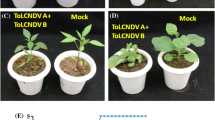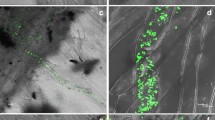Abstract
Tomato leaf curl virus (ToLCV) disease is a serious threat for tomato cultivation in the tropics and subtropics. Despite serious efforts no immune commercial varieties or F1 hybrids are available till date. In this study, the interaction between Solanum lycopersicum and ToLCV was characterized on molecular and biochemical basis. RNA silencing mediated by short interfering RNA (siRNA) and reactive oxygen species (ROS) has been proposed as central components of plant adaptation to several stresses. A comparative RNA interference study between two contrasting tomato genotypes, LA1777 (tolerant) and 15SBSB (susceptible) infected with Tomato Leaf Curl New Delhi Virus (ToLCNDV) revealed relatively higher accumulation of siRNA in the leaves of tolerant genotype. In LA1777, ToLCNDV produced chlorotic as well as necrotic areas at the inoculation sites 5–10 days post-inoculation. Caspase-9- and caspase-3-like activities were significantly increased in response to ToLCNDV infection in LA1777 at inoculated region. Activities of antioxidant enzymes involved in the detoxification of ROS were examined in both systemic and localized area of infection, and their expression level was further validated through quantitative real-time PCR of the corresponding transcripts. Expression patterns of three genes encoding pathogenesis-related proteins showed higher accumulation in tolerant genotype. Tolerance against the ToLCNDV in LA1777 can be attributed to the higher siRNA accumulation, localized cell death, altered levels of antioxidant enzymes and activation of pathogenesis-related genes at different durations of virus infection. Based on these direct and indirect evidences, we have proposed a putative mechanism for ToLCNDV tolerance in the tolerant genotype.






Similar content being viewed by others
Abbreviations
- ToLCNDV:
-
Tomato Leaf Curl New Delhi Virus
- siRNA:
-
Short interfering RNA
- qRT-PCR:
-
Quantitative real-time polymerase chain reaction
References
Green, S. K., & Kalloo, G. (1994). Leaf curl and yellowing viruses of pepper and tomato: An overview. Technical Bulletin 21. Shanhua: Asian Vegetable Research and Development Center.
Muniyappa, V., Venkatesh, H. M., Ramappa, H. K., Kulkarni, R. S., Zeidan, M., Tarba, C. Y., et al. (2000). Tomato yellow leaf curl virus from Bangalore (ToLCV-Ban4): Sequence comparison with Indian ToLCV isolates, detection in plants and insects, and vector relationships. Archives of Virology, 145, 1583–1598.
Chakraborty, S., Pandey, P. K., Banerjee, M. K., Kalloo, G., & Fauquet, C. M. (2003). Tomato leaf curl Gujarat virus, a new begomovirus species causing a severe leaf curl disease of tomato in Varanasi, India. Phytopathology, 93, 1485–1495.
Krause-Sakate, R., Redondo, E., Richard-Forget, F., Jadao, A. S., Houvenaghel, M. C., German-Retana, S., et al. (2005). Molecular mapping of the viral determinants of systemic wilting induced by a Lettuce mosaic virus (LMV) isolate in some lettuce cultivars. Virus Research, 109, 175–180.
Ding, S. W., & Voinnet, O. (2007). Antiviral immunity directed by small RNAs. Cell, 130, 413–426.
Sahu, P. P., Rai, N. K., Chakraborty, S., Singh, M., Prasanna, H. C., Ramesh, B., et al. (2010). Tomato cultivar tolerant to Tomato leaf curl New Delhi virus infection induces virus-specific short interfering RNA accumulation and defense-associated host gene expression. Molecular Plant Pathology, 11, 531–544.
Seo, Y. S., Gepts, P., & Gilbertson, R. L. (2004). Genetics of resistance to the geminivirus, Bean dwarf mosaic virus, and the role of the hypersensitive response in common bean. Theoretical Applied Genetics, 108, 786–793.
Culver, J. N., & Padmanabhan, M. S. (2007). Virus-induced disease: Altering host physiology one interaction at a time. Annual review of Phytopathology, 45, 221–243.
Carr, J. P., Lewsey, M. G., & Palukaitis, P. (2010). Signaling in induced resistance. Advances in Virus Research, 76, 57–121.
Llave, C. (2010). Virus-derived small interfering RNAs at the core of plant-virus interactions. Trends in Plant Science, 15, 701–707.
Cohn, J., Sessa, G., & Martin, G. B. (2001). Innate immunity in plants. Current Opinion in Immunology, 13, 55–62.
Radwan, D. E. M., Fayez, K. A., Mahmoud, S. Y., Hamad, A., & Lu, G. (2006). Salicylic acid alleviates growth inhibition and oxidative stress caused by Zucchini yellow mosaic virus infection in Cucurbita pepo leaves. Physiology & Molecular Plant Pathology, 69, 172–181.
Noctor, G., & Foyer, C. H. (1998). Ascorbate and glutathione: Keeping active oxygen under control. Annual Review of Plant Physiology Plant Molecular Biology, 492, 249–279.
Técsi, L. I., Smith, A. M., Maule, A. J., & Leegood, R. C. (1996). A spatial analysis of physiological changes associated with infection of cotyledons of marrow plants with cucumber mosaic virus. Plant Physiology, 111, 975–985.
Radwan, D. E. M., Fayez, K. A., Mahmoud, S. Y., Hamad, A., & Lu, G. (2007). Physiological and metabolic changes of Cucurbita pepo leaves in response to zucchini yellow mosaic virus (ZYMV) infection and salicylic acid treatments. Plant Physiology & Biochemistry, 45, 480–489.
Hodgson, R. A. J., & Raison, J. K. (1991). Lipid peroxidation and superoxide dismutase activity in relation to photo-inhibition induced by chilling in moderate light. Planta, 185, 215–219.
Schaedle, M., & Bassham, J. A. (1977). Chloroplast glutathione reductase. Plant Physiology, 59, 1011–1012.
Chance, B., & Maehley, A. (1955). Assay of catalases and peroxidases. Methods in Enzymology, 2, 764.
Stasolla, C., & Yeung, E. C. (2001). Ascorbic acid metabolism during white spruce somatic embryo maturation and germination. Physiologia Plantarum, 111, 196–205.
Li, Z. S., Zhen, R. G., & Rea, P. A. (1995). 1-chloro-2,4-dinitrobenzene-elicited increase in vacuolar glutathione-S-conjugate transports activity. Plant Physiology, 109, 177–185.
Livak, K. J., & Schmittgen, T. D. (2001). Analysis of relative gene expression data using real-time quantitative PCR and the 2(−∆∆C (T)) method. Methods, 25, 402–408.
Hussain, M., Mansoor, S., Iram, S., Fatima, A. N., & Zafar, Y. (2005). The nuclear shuttle protein of Tomato leaf curl New Delhi virus is a pathogenicity determinant. Journal of Virology, 79, 4434–4439.
del Pozo, O., & Lam, E. (1998). Caspase and programmed cell death in the hypersensitive response of plants to pathogens. Current Biology, 8, 1129–1132.
Mlejnek, P., & Prochazka, S. (2002). Activation of caspase-like protease and induction of apoptosis by isopentenyladenosine tobacco BY-2 cells. Planta, 215, 158–166.
Li, Z., & Burritt, D. J. (2003). The influence of Cocksfoot mottle virus on antioxidant metabolism in the leaves of Dactylis glomerata L. Physiology & Molecular Plant Pathology, 62, 285–295.
Wise, R. R., & Naylor, A. W. (1987). Chilling-enhanced photooxidation. Plant Physiology, 83, 278–282.
Herna’ndez, J. A., Di’az-Vivancos, P., Rubio, M., Olmos, E., Ros-Barcelo, E., & Marti’nez-Go’mez, P. (2006). Long-term plum pox virus infection produces an oxidative stress in a susceptible apricot, Prunus armeniaca cultivar but not in a resistant cultivar. Physiologia Plantarum, 126, 140–152.
Riedle-Bauer, M. (1998). Activities of antioxidant enzymes in cucumber plants infected with Cucumber mosaic virus. Phyton-Annales Rei Botanicae, 38, 149–157.
Clarke, P. L., Guy, D. J., & Burritt, P. E. (2002). Changes in the activities of antioxidant enzymes in response to virus infection and hormone treatment. Physiologia Plantarum, 114, 157–164.
Nadlong, L., & Sequeira, L. (1980). Increases in peroxidase activities are not directly involved in induced resistance to Tobacco mosaic virus. Physiology & Molecular Plant Pathology, 16, 1–8.
Riedle-Bauer, M. (2000). Role of reactive oxygen species and antioxidant enzymes in systemic virus infections of plants. Journal of Phytopathology, 148, 297–302.
Chen, Z., Todd, E., Young, J. L., Su-Chih, C., & Daniel, R. G. (2003). Increasing vitamin C content of plants through enhanced ascorbate recycling. Proceedings of the National Academy of Sciences of the United States of America, 100, 3525–3530.
Asada, K. (1999). The water–water cycle in chloroplasts: Scavenging of active oxygen, dissipation of excess photons. Annual Review of Plant Physiology Plant Molecular Biology, 50, 601–639.
Farkas, G. L., Király, Z., & Solymosi, F. (1960). Role of oxidative metabolism in the localization of plant viruses. Virology, 12, 408–421.
Fodor, J., Gullner, G., Adam, A. L., Barna, B., Koemives, T., & Kiraly, Z. (1997). Local and systemic responses of antioxidants to Tobacco mosaic virus infection and to salicylic acid in tobacco. Plant Physiology, 114, 1443–1451.
Hao, Z., Wang, L., He, Y., Liang, J., & Tao, R. (2011). Expression of defense genes and activities of antioxidant enzymes in rice resistance to rice stripe virus and small brown planthopper. Plant Physiology & Biochemistry, 49, 744–751.
Fraser, R. S. S. (1982). Are ‘pathogenesis-related’ proteins involved in acquired systemic resistance of tobacco plants to tobacco mosaic virus? Journal of General Virology, 5, 305–313.
Bowling, S. A., Guo, A., Cao, H., Gordon, S., Klessig, D. F., & Dong, X. (1994). A mutation in Arabidopsis that leads to constitutive expression of systemic acquired resistance. Plant Cell, 6, 1845–1857.
Love, A. J., Laval, V., Geri, C., Laird, J., Tomos, D. A., Hooks, M. A., et al. (2007). Components of Arabidopsis defense- and ethylene-signaling pathways regulate susceptibility to Cauliflower mosaic virus by restricting long-distance movement. Molecular Plant Microbe Interaction, 20, 659–670.
Apel, K., & Hirt, H. (2004). Reactive oxygen species: Metabolism, oxidative stress, and signal transduction. Annual Review of Plant Biology, 55, 373–399.
Choi, H. W., Kim, Y. J., Lee, S. C., Hong, J. K., & Hwang, B. K. (2007). Hydrogen peroxide generation by the pepper extracellular peroxidase CaPO2 activates local and systemic cell death and defense response to bacterial pathogens. Plant Physiology, 145, 890–904.
Acknowledgements
We are grateful to the Director, National Institute of Plant Genome Research for providing facilities; to the Council for Scientific and Industrial Research, Govt. of India for providing a Senior Research Fellowship to Mr. Neeraj K Rai; to Dr. S. Chakraborty, SLS, JNU, New Delhi, India, for providing virus construct for agroinoculation and to Dr. A. T. Sadashiva, IIHR, Bangalore, India, for seed material. We gratefully acknowledge the financial support from the Department of Biotechnology, Government of India (Grant no. BT/PR/5274/AGR/16/464/2004).
Author information
Authors and Affiliations
Corresponding author
Electronic Supplementary Material
Below is the link to the electronic supplementary material.
12033_2011_9481_MOESM1_ESM.doc
Supplementary Fig. S1 Trypan blue stained nodes of LA1777 and 15SBSB genotypes infected with Tomato leaf curl New Delhi virus at different day post-inoculation. (DOC 1518 kb)
Rights and permissions
About this article
Cite this article
Sahu, P.P., Rai, N.K., Puranik, S. et al. Dynamics of Defense-Related Components in Two Contrasting Genotypes of Tomato Upon Infection with Tomato Leaf Curl New Delhi Virus . Mol Biotechnol 52, 140–150 (2012). https://doi.org/10.1007/s12033-011-9481-8
Published:
Issue Date:
DOI: https://doi.org/10.1007/s12033-011-9481-8




